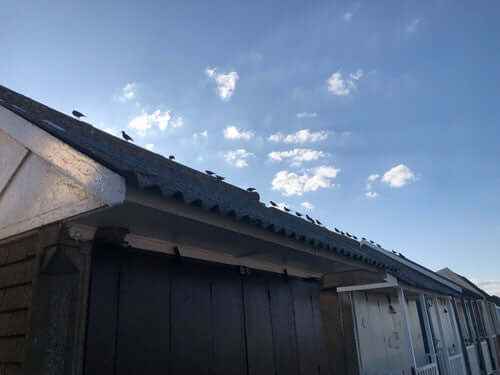Welcome to this week's wildlife adventures with an iPhone, I'd like to share a short video of one of my favourite wild birds - the House Martin.
Actually, it’s three times better than that because I’m sharing a video of not one, but three House Martins and they’re chicks. Does it get any better than this?
These three handsome House Martin chicks seemed content enough to play a bit of a game with passers-by, first drawing attention to themselves with competitive calls for more food quickly followed by unanimous vows of temporary silence and togetherness emphasised by a quick duck for cover on first sight of people taking a stroll along the promenade. When the coast was clear, the chicks emerge boisterously and shoulder barge one another for pole position, awaiting the gift of an insect or two.
The birds' parents made little fuss of walkers and their dogs staring up at their offspring - I suppose it's all in a day's work if you choose to build the family home under the eaves of a beach hut.
At this time of year, the beach huts are home to many House Martin families; I've been observing their nesting activities on and off for several years. It's fascinating that these youngsters will soon take to the air themselves and by September embark on a journey that will take them from the relatively cool coastline of Lincolnshire along an unforgiving migration path to a sub-Saharan arid Africa for autumn/winter. If that wasn't amazing enough, it’s a return journey! They'll make their way back to Britain by next April.
Isn't it fantastic that these three fresh faces could soon be swooping between the legs of a rhino or sat on a crocodile's back at the local watering hole? No, not the pub. The one in North Africa. Now that's what I call a wildlife adventure. (Although I'm not so keen on being sat on the back of an old croc or a young croc or, now I think about it, any age croc!).
The House Martin is a supreme flyer - catching insects in flight and outmanoeuvring most of its avian predators. There's little we can do to feed House Martins other than to reduce chemicals in the garden and make space for a pond (any size would be appreciated) as water brings bug life and mud (for nest building and repairs) which might just help a family of House Martins get into great shape for the flight of their life.
Before I leave you, however, I'd like to share this photo of Starlings perched on the roof of the very same beach huts the House Martins have made their summer home.

Sadly, the jury is often out on Starlings - many people think of them as a nuisance, noisy and uncouth - but I'm in the other camp. I think they're gregarious, industrious and handsome (OK, and noisy!). When I tell people that Starlings are handsome I can see them recoil as they struggle to grasp the unsung looks of the personable, good-looking and athletic Sturnus vulgaris (the Starling). I know I know, its latin name doesn't help my argument does it? But take a closer look at its iridescent plumage, punctuated by white spots, and I dare you to say this isn't a bird with kerb appeal - which is exactly why I took this photo. Actually, it wasn't a kerb it was a promenade - so, it has promenade appeal - which is even more special than kerb appeal.

Here's one more reason to enjoy and appreciate the Starling - "Long-term monitoring by the British Trust for Ornithology (BTO) shows that starling numbers have fallen by 66 per cent in Britain since the mid-1970s. Because of this decline in numbers, the starling is red-listed as a bird of high conservation concern." – BTO.
Given this freefalling population decline, perhaps the Starling is in its rights to shout a bit louder than the average garden bird?!



